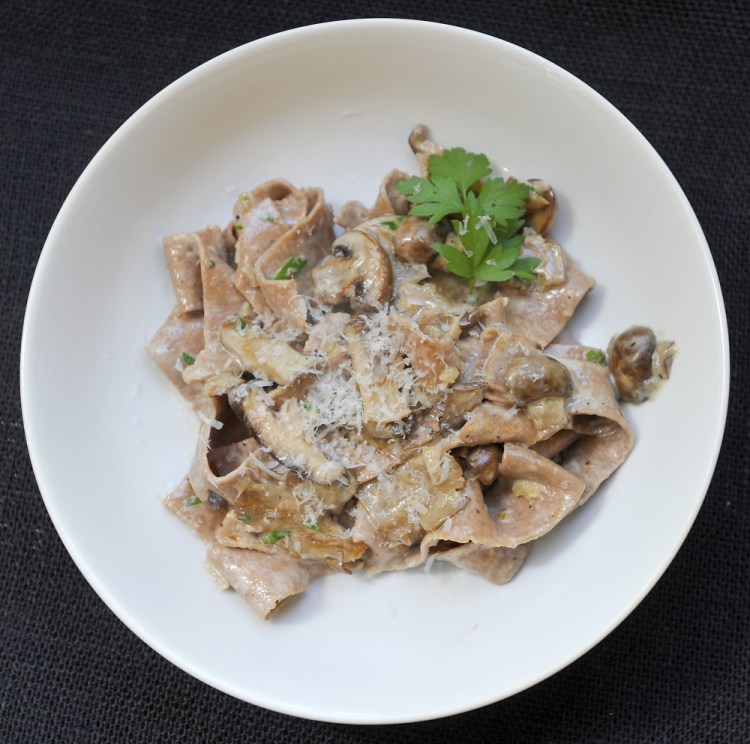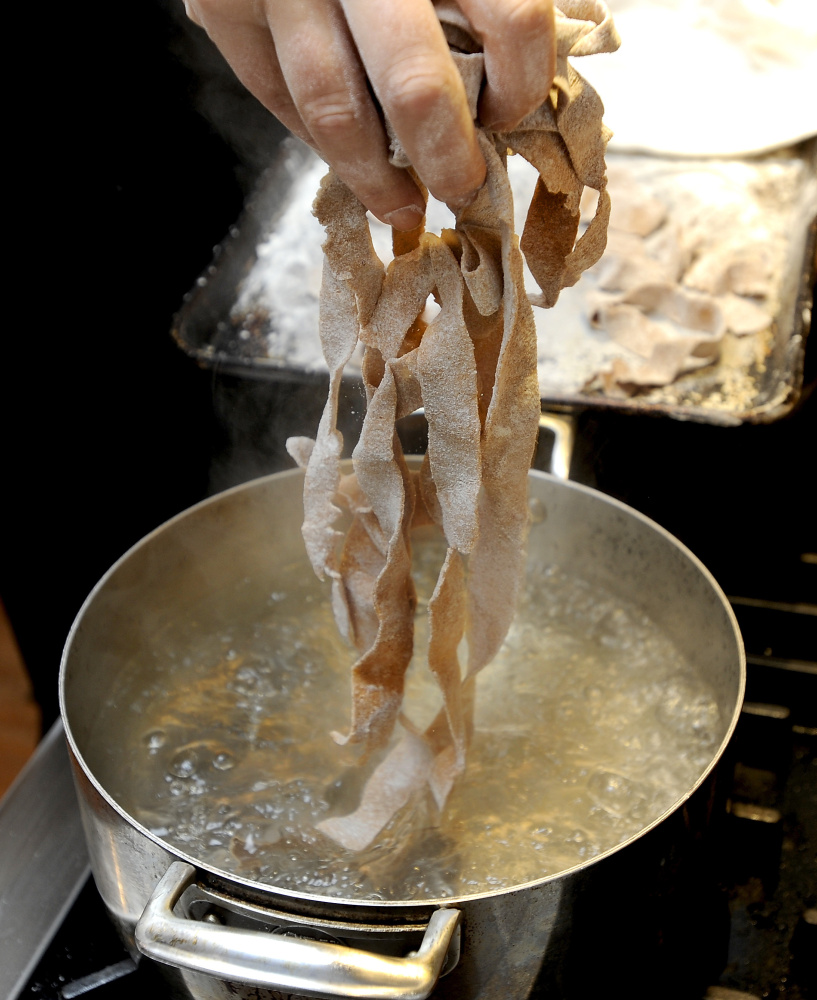Chris Knapp began a recent class on processing red oak nuts with a beautiful story about how the first tree gifted its acorns to the four- and two-legged creatures sharing the forest in which it thrived.
He told the 20 permaculturists present at the event – sponsored by the Maine Permaculture Resilience Hub but held at a private home in Cape Elizabeth – that the four-legged creatures have always consumed these nutrient-dense packages with abandon. But modern Mainers’ interest in eating acorns has fallen way off the high mark set by Native Americans, who used the nut flour in soup, mush, biscuits and bread.
Knapp has processed a ton of acorns (and we mean that literally), for his family’s consumption on their homestead in Temple and to demonstrate the process to attendees at the Koviashuvik Local Living School (mainelocalliving.com) he operates there. He’s hooked on acorn flour because it’s locally sourced, yields one pound of flour per two pounds of nuts, and can be substituted for 50 percent of the flour in any bread recipe.
The result will be denser because of the high-fat content of acorns and will taste and smell different because of the flour’s very nutty taste and woody nose. “But it will become your new favorite bread recipe,” he said.
The only commercially available acorn flour comes from Korea, where it is used in making noodles. Knapp carefully explains to pupils who want to enjoy acorn flour that they’ve got to make it themselves. Be forewarned: It’s an involved process.
The time to harvest acorns is now. The oaks start dropping nuts in late September and hold off on dropping their leaves until the all acorns have fallen in early November. Good acorns can be both fat and round and skinny and oval, but they should never be wearing their caps, have pinholes (one means the weevil is still in the nut, two means he came and left), or be black.
Acorns must be passively dried for three to six weeks so they don’t mold in storage and so the shells crack easily to start the flour-making process. A sunny window sill works for small amounts; larger quantities can be spread out in pizza boxes on radiators. Dried acorns can be stored for years.
To crack open the shells, Knapp places a wooden disk in the bottom of a 5-gallon bucket, covers it with a layer of acorns and crushes them with a heavy wooden mallet – while singing. Since the nut meat sinks and shells float, the two are easily separated in water. Spreading the meats out on a screen with a 1/4-inch weave gives shell pickers a bird’s eye view of larger pieces that may have stuck around while tiny fragments fall through.
Knapp runs the nut meats through a $50 Corona corn and grain grinder, as finer grain mills will clog due to the high fat content. He sifts the grind through a series of screens with progressively smaller holes and gets chunks that he fries and salts for snacking; grits that he uses for porridge; and flour for baking.
Still, each of these products is inedible at this juncture because of the acorn’s inherent bitter tannins. So the chunks, grits and flour have to be leached for 3 days, 12 hours and 8 hours respectively.
Knapp lines a colander with Reemay garden cloth; makes a paste of water and the acorn chunks, grits or flour; and spreads the paste an inch thick over the Reemay. He then runs a steady stream of water to keep the acorn mixture submerged for the requisite period of time. From there, the acorn products can be stored wet in the refrigerator for 3 weeks and used in most recipes, with a little less liquid than the recipe calls for, or they can be dried or frozen and stored for two months.
Knapp admits the long process is a labor of love. But he contends it’s one that honors the oak’s gift.
ACORN TAGLIATELLE WITH MUSHROOM CREAM SAUCE
Oct. 25 is World Pasta Day. This nutty, earthy dish is worth celebrating! If you’ve not milled your own acorn flour (which is well worth the extra flavor and the sustainability points), you can use Korean acorn flour ,which is available at Sun Oriental Market on Congress Street in Portland.
Makes 4 servings
FOR PASTA:
1 cup acorn flour
1 cup all-purpose flour
1/4 teaspoon salt, plus 2 tablespoons for pasta water
2 whole eggs plus 2 egg yolks
FOR SAUCE:
1 tablespoon butter
12 ounces wild mushrooms, sliced
1/3 cup finely chopped shallots
1 tablespoon minced garlic
11/2 teaspoons salt
1/4 teaspoon freshly ground black pepper
1/4 cup dry white wine
2/3 cup heavy cream
1/2 cup grated fresh Parmigiano-Reggiano cheese (about 2 ounces)
2 tablespoons chopped fresh parsley
To make pasta, combine flours and ¼ teaspoon salt in a medium bowl. Make a well in the center of the flour and add eggs to it. Whisk eggs with a fork to combine, and gradually pull flour from the bottom and sides of the bowl into the egg mixture.
Once the dough starts to come together, turn it and any excess flour out onto a clean counter.
Knead it until the dough forms an elastic ball (about 3 minutes). Wrap dough in a towel and let it rest for at least 30 minutes but up to 12 hours.
Sprinkle a baking sheet generously with flour. Place dough on the sheet and divide it into 4 portions. Dust each with flour and cover with a clean dish towel.
Using either a pasta machine or a large rolling pin, roll out each piece of dough very thinly (about 1/16 of an inch). Cut each sheet of pasta in 1/2-inch ribbons. Dust the ribbons with more flour to keep them from sticking to each other. Repeat until all dough portions have been rolled and cut.
To make the sauce, melt butter in a large nonstick skillet over medium-high heat. Add mushrooms, shallots, garlic, 1 teaspoon salt, and pepper; cook until liquid evaporates and mushrooms are tender (about 10-12 minutes), stirring occasionally. Stir in wine; cook until liquid evaporates (about 2 minutes). Remove from heat.
Set a large pot of water and two tablespoons of salt over medium high heat. Cover and bring water to a boil. Cook pasta in boiling water for four minutes, drain.
Place pan of mushrooms back over medium heat. Add cooked pasta, cream, cheese and 2 tablespoons parsley, tossing gently to coat. Stir in remaining 1/2 teaspoon salt if needed. Serve immediately.
Christine Burns Rudalevige is a food writer, recipe developer and tester, and cooking teacher in Brunswick. She can be contacted at cburns1227@gmail.com.
Send questions/comments to the editors.




Success. Please wait for the page to reload. If the page does not reload within 5 seconds, please refresh the page.
Enter your email and password to access comments.
Hi, to comment on stories you must . This profile is in addition to your subscription and website login.
Already have a commenting profile? .
Invalid username/password.
Please check your email to confirm and complete your registration.
Only subscribers are eligible to post comments. Please subscribe or login first for digital access. Here’s why.
Use the form below to reset your password. When you've submitted your account email, we will send an email with a reset code.